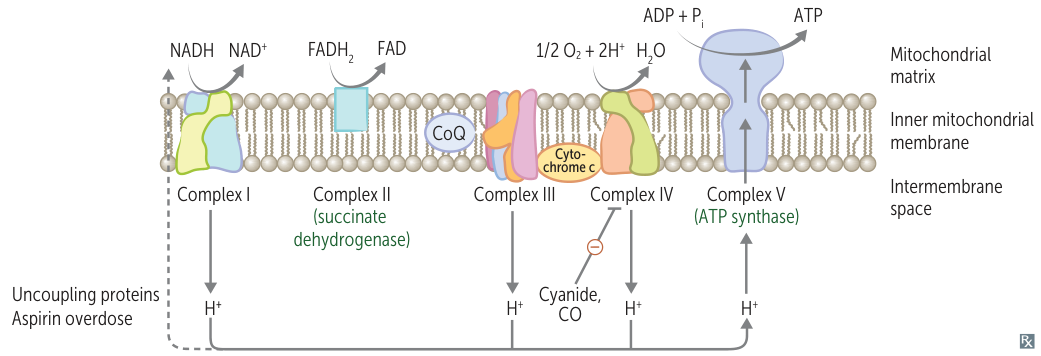
- Overall Goal & Location
- Location: Inner mitochondrial membrane.
- Goal: To couple the energy released from the oxidation of electron carriers (NADH, FADH₂) to the phosphorylation of ADP, generating ATP. Final electron acceptor is O₂.
- Components of the ETC
- Complex I (NADH Dehydrogenase)
- Accepts electrons from NADH.
- Pumps H⁺ into the intermembrane space.
- Transfers electrons to Coenzyme Q.
- Complex II (Succinate Dehydrogenase)
- Accepts electrons from FADH₂ (generated from the succinate → fumarate step of the TCA cycle).
- Does NOT pump protons.
- Transfers electrons to Coenzyme Q.
- Coenzyme Q (Ubiquinone)
- A mobile, lipid-soluble carrier that accepts electrons from Complex I and II.
- Transfers electrons to Complex III.
- Complex III (Cytochrome bc₁ Complex)
- Accepts electrons from Coenzyme Q.
- Pumps H⁺.
- Transfers electrons to Cytochrome c.
- Cytochrome c
- A mobile protein that accepts electrons from Complex III.
- Transfers electrons to Complex IV.
- Complex IV (Cytochrome c Oxidase)
- Accepts electrons from Cytochrome c.
- The final step: reduces O₂ to H₂O.
- Pumps H⁺.
- Chemiosmotic Theory & ATP Synthase
- The pumping of H⁺ by Complexes I, III, and IV creates an electrochemical gradient across the inner mitochondrial membrane, known as the proton-motive force.
- ATP Synthase (Complex V) harnesses this force, allowing H⁺ to flow back into the mitochondrial matrix, driving the synthesis of ATP from ADP + Pi.
- Energy Yield (P/O Ratio)
- 1 NADH → ~2.5 ATP (enters at Complex I, contributing to H⁺ pumping at 3 sites).
- 1 FADH₂ → ~1.5 ATP (enters at Complex II, contributing to H⁺ pumping at only 2 sites).
- High-Yield Inhibitors & Uncouplers
- ETC Inhibitors: Cause a backup of electrons and ↓ proton gradient, leading to ↓ ATP synthesis and ↓ O₂ consumption.
- Complex I Inhibitor: Rotenone (insecticide).
- Complex III Inhibitor: Antimycin A.
- Complex IV Inhibitors: Cyanide (CN⁻), Carbon Monoxide (CO), Azide. These bind to Fe³⁺ in cytochrome oxidase.
- ATP Synthase (Complex V) Inhibitor: Oligomycin. Blocks H⁺ flow, causing the proton gradient to become so large the ETC stops.
- Uncoupling Agents: Disrupt the coupling between electron transport and ATP synthesis by increasing the permeability of the inner membrane to H⁺.
- Effect: ETC runs continuously, leading to ↑ O₂ consumption and ↑ NADH/FADH₂ oxidation. The proton gradient is dissipated, so ↓ ATP synthesis. The lost energy is released as heat (can cause hyperthermia).
- Examples:
- 2,4-Dinitrophenol (2,4-DNP): An illicit weight loss drug.
- Aspirin (salicylates): Overdose can cause fever by uncoupling.
- Thermogenin (UCP-1): Found in brown adipose tissue of newborns for temperature regulation.
